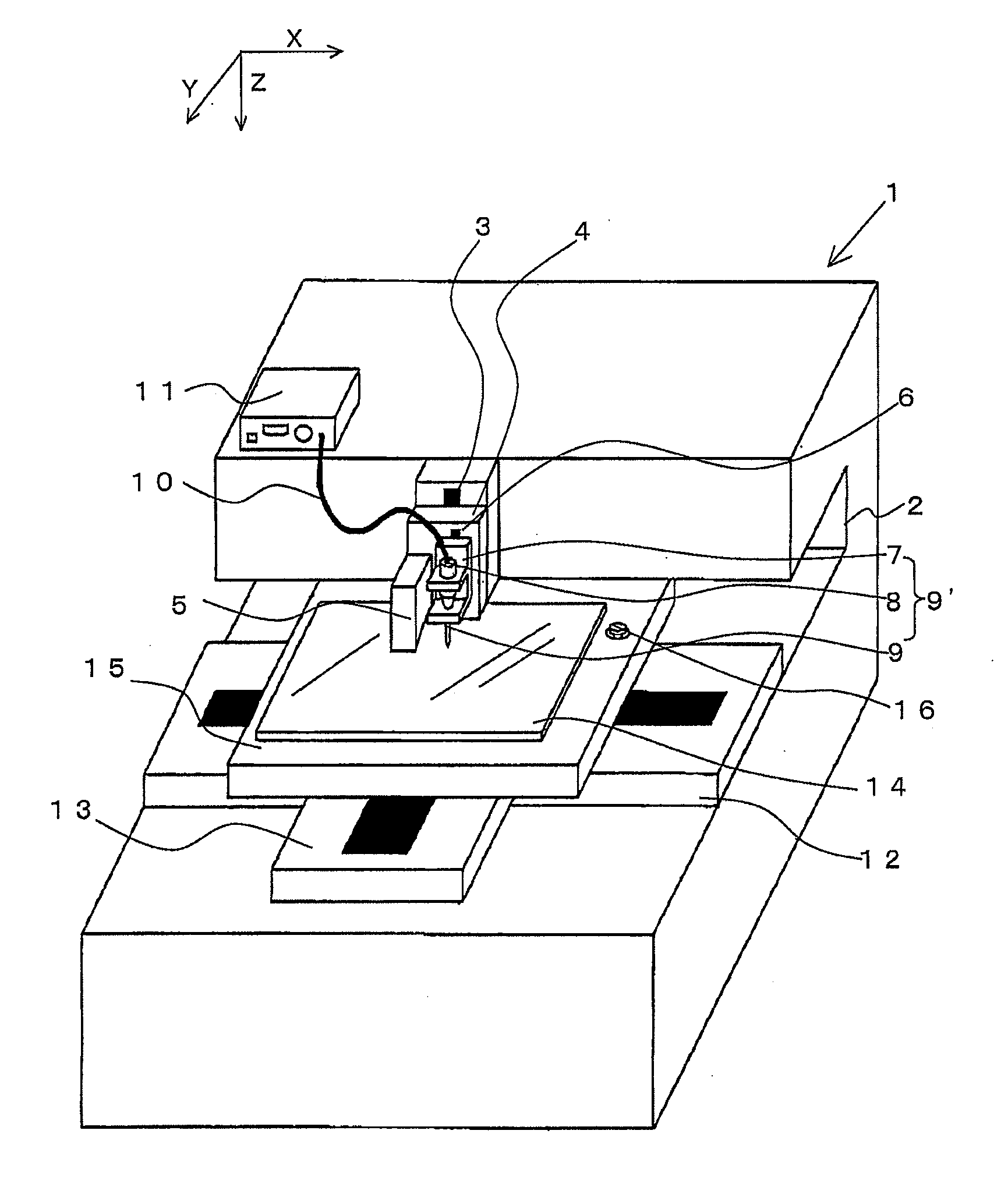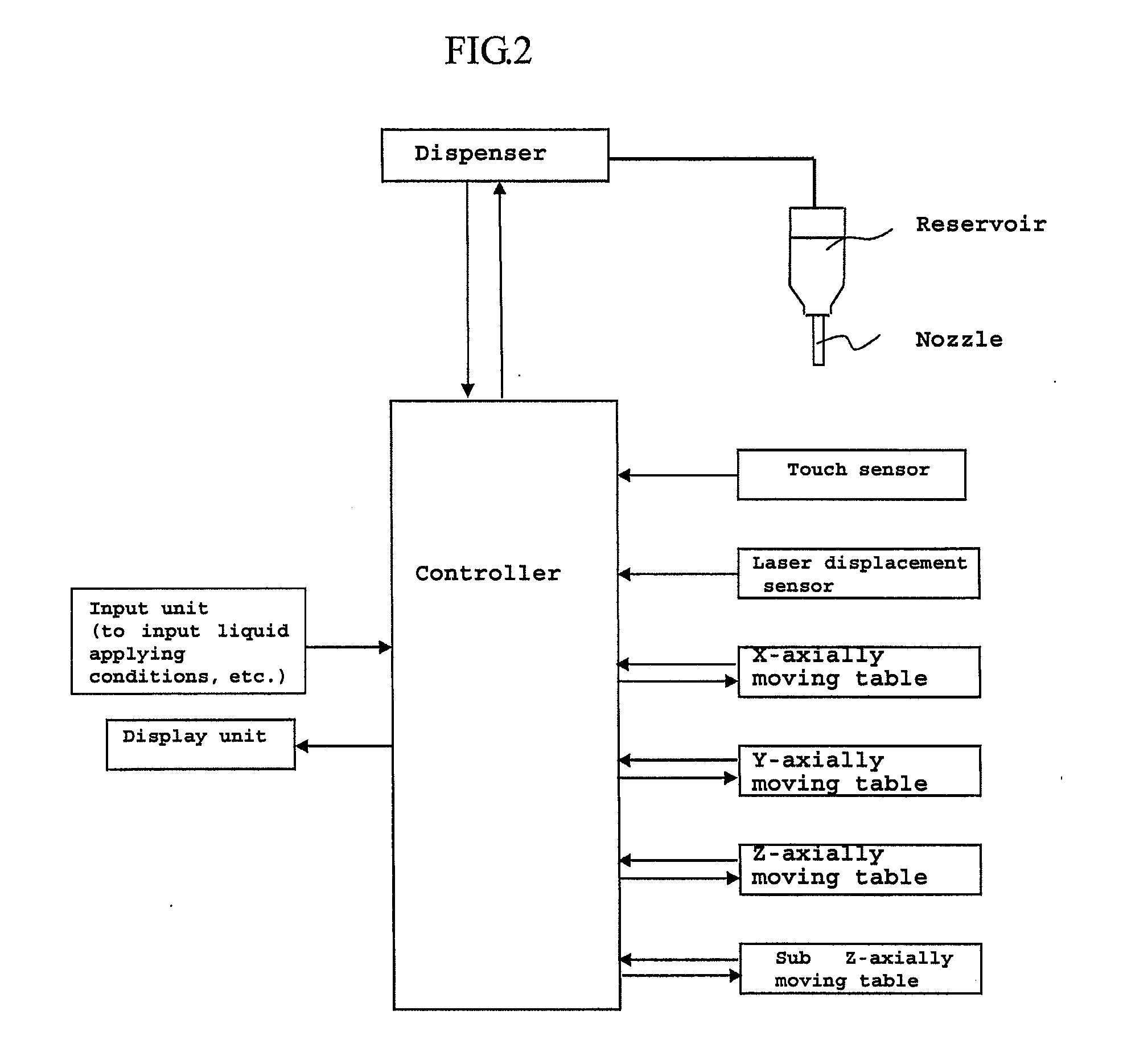Method of adjusting nozzle clearance of liquid application apparatus, and liquid application apparatus
a technology of liquid application apparatus and nozzle clearance, which is applied in the direction of water supply installation, drawing-off water installations, instruments, etc., can solve the problems of inaccurate adjustment of nozzle clearance, inability to reproduce precisely nozzle clearance, and misalignment of nozzle and non-contact distance sensors, so as to reduce the influence caused by windings, accurately adjust nozzle clearance, and accurately obtain
- Summary
- Abstract
- Description
- Claims
- Application Information
AI Technical Summary
Benefits of technology
Problems solved by technology
Method used
Image
Examples
embodiment 1
[0092]This embodiment is the liquid application apparatus (shown in FIG. 1) using the Z-axially moving table 3, sub Z-axially moving table 6 and touch sensor 16 as the vertical position changer. The nozzle clearance is adjusted as will be explained below with reference to the flow diagram shown in FIG. 3 and FIGS. 4 (a)-4(d).
[0093](1) Step 1 (Power-up):
[0094](2) Step 2 (Setting of liquid applying conditions):
[0095]The apparatus operator makes entry of liquid applying conditions such as a position where the application is to be started, pressure of air supplied from the application apparatus 11, nozzle clearance, etc.
[0096](3) Step 3 (Distance measurement step): As shown in FIG. 4(a), the X- and Y-axially moving tables 12 and 13 are driven for the laser displacement sensor 5 to come to just above the touch sensor 16, laser light is emitted from the laser displacement sensor 5 to the reference surface 19a of the touch sensor 16, and return light from the touch sensor 16 is detected by...
embodiment 2
[0120]There will be explained with reference to the flow diagram in FIG. 3 and the step chars in FIGS. 7 (a)-7(c) how to adjust the nozzle clearance in a sealant application apparatus (see FIG. 6) in which the Z-axially moving table 3 and touch sensor 6 are used as the vertical position changers according to another embodiment of the present invention. It should be noted that operations up to step 5 in FIG. 3 are effected as having been described above.
[0121]In step 6, the Z-axial relative position between the nozzle 9 and laser displacement sensor 5 is adjusted. In this adjustment, a Z-axial relative position between the nozzle and laser displacement sensor (distance Zn-Z1 from the front end of the nozzle 9 to the touch-sensor reference surface 19a when the distance from the laser displacement sensor 5 to the touch-sensor reference surface 19a is L1) is obtained based on the values (L1, Z1, Zn) measured in steps 3 and 5 as shown in FIGS. 7(a) and 7(b). So, a value Lc is measured ba...
embodiment 3
[0123]Here will be explained how to adjust the nozzle clearance in the sealant application apparatus shown in FIG. 1 by a method different from that in the embodiment 1. This embodiment 3 and embodiment 1 are different from each other as follows. In the embodiment 1, in step 5 where the nozzle 9 is moved into touch with the reference surface 19a, the Z-axially moving table 3 is driven to put the nozzle 9 into touch at the front end thereof with the reference surface 19a of the touch sensor 16. In this embodiment 3, however, the sub Z-axially moving table 6 is driven to put the nozzle 9 into touch at the front end with the reference surface 19a of the touch sensor 16. Further, in the embodiment 1, the Z-axially moving table 3 is driven to move the nozzle 9 vertically in step 7. In this embodiment 3, however, the sub Z-axially moving table 6 is driven to move the nozzle 9 vertically.
[0124]The nozzle clearance adjustment by this method will be explained below with reference to the flow...
PUM
| Property | Measurement | Unit |
|---|---|---|
| diameter | aaaaa | aaaaa |
| distance | aaaaa | aaaaa |
| distance measurement | aaaaa | aaaaa |
Abstract
Description
Claims
Application Information
 Login to View More
Login to View More - R&D
- Intellectual Property
- Life Sciences
- Materials
- Tech Scout
- Unparalleled Data Quality
- Higher Quality Content
- 60% Fewer Hallucinations
Browse by: Latest US Patents, China's latest patents, Technical Efficacy Thesaurus, Application Domain, Technology Topic, Popular Technical Reports.
© 2025 PatSnap. All rights reserved.Legal|Privacy policy|Modern Slavery Act Transparency Statement|Sitemap|About US| Contact US: help@patsnap.com



